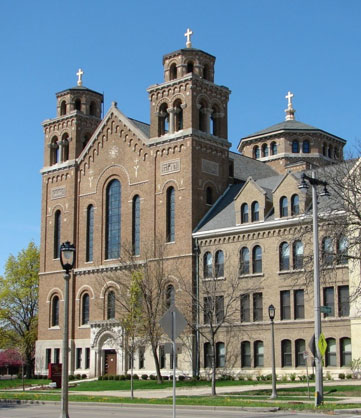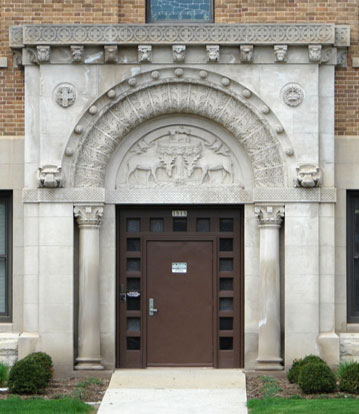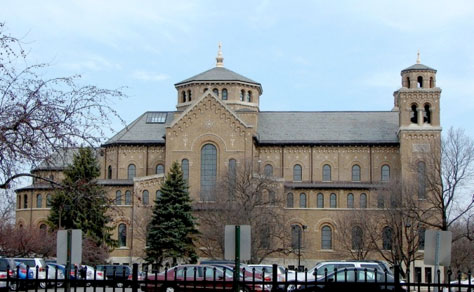19. St. Joseph’s Convent Chapel, 1914
1501 South Layton Boulevard (at Orchard Street)
Architects: Brust and Philipp
The School Sisters of St. Francis is a Catholic congregation of nuns with its international headquarters in Milwaukee. The congregation was founded by three nuns who came to Wisconsin from Germany in the early 1870s and established a mission in New Cassel (now the village of Campbellsport) in Fond du Lac County. After briefly relocating to Winona, Minnesota in 1885, the group moved again in the following year, establishing its motherhouse in Milwaukee. In its early years, the congregation focused mainly on training nuns to serve as teachers in Catholic schools in Wisconsin and other Midwestern states. In 1887, the School Sisters established a teachers’ training academy in Milwaukee, which later grew to become Alverno College, one of the nation’s largest Catholic women’s colleges. Today, the School Sisters of St. Francis has ministries throughout the United States as well as in Latin America, Europe, and India, focusing primarily on education and health care.
The first convent built for the School Sisters in Milwaukee was destroyed by fire in 1890. The oldest portion of the present convent dates to 1891, with later additions extending the building more than 400 feet along Layton Boulevard. In 1914, work began on the present chapel, attached to the south end of the larger convent.
Peter Brust (c. 1870-1946) and Richard Philipp (1874-1959) received the commission to design the new chapel. The two men practiced as a partnership in Milwaukee from 1906 to 1927. Both men had previously spent several years working in the office of Ferry and Clas, one of the city’s most distinguished architectural firms. Brust and Philipp had a large and varied practice, which at one point was the largest architectural office in Wisconsin. In addition to the chapel for St. Joseph’s Convent, the firm designed at least three other churches in Milwaukee. Two of these are also Romanesque Revival designs: St. Augustine of Hippo Catholic in the Bay View neighborhood (built in 1908) and St. Anne’s Catholic (now Mercy Memorial Baptist) on the North Side (built in 1919).
Although it is not the largest in terms of seating capacity, the chapel is the largest of Milwaukee’s Romanesque Revival places of worship in terms of its footprint and volume. The building is 200 feet in length and more than 80 feet in width at the transepts. On the interior, there is a shallow dome of stained glass beneath the eight-sided tower at the crossing of the nave and transepts. The dome is 70 feet above the floor. Excluding towers and steeples, the chapel is considerably taller than the city’s other Romanesque Revival places of worship. The basilican plan chapel has balconies above the side aisles, so there are three levels of windows along the sides: on the main floor, in the balconies, and clerestory windows in the nave.
St. Joseph’s Convent Chapel is also one of the most richly ornamented places of worship in Milwaukee. Interior finishes include marble from 15 different locations, including quarries in France, Germany, Greece, Italy, Mexico, Switzerland, and the United States. There are 115 stained glass windows, all imported from Innsbruck, Austria. The chapel was featured in The American Architect in 1918, with two floor plans and a dozen photographs. The photographs show a great deal of decorative painting on the interior walls, arches, and ceiling vaults. As is typical of the city’s older places of worship, much of this ornamental work has since been painted over.
Because the chapel was initially used only by the nuns, who entered from the attached convent building to the north, there is only a small entrance on the façade. This entrance is nonetheless extensively ornamented with carved stone. Since the 1970s, the chapel has occasionally been opened to the public for choir concerts and other events.
Sources:
The American Architect, May 1, 1918. Photographs of St. Joseph’s Convent Chapel, plates 160-169.
Brust and Philipp, architects. Prints of drawings for construction of St. Joseph’s Catholic Convent Chapel (incomplete set), dated April and September 1914. Wisconsin Architectural Archive, Milwaukee Central Library, drawing set 148-146.
“Brust, Veteran Architect, Dies,” Milwaukee Journal, June 23, 1946, Section II, page 1, column 7.
“Chapel Here One of Most Beautiful on Continent,” Milwaukee Sentinel, June 8, 1930, page A9, column 2.
Euper, Jo Ann. 1st Century of Service: the School Sisters of St. Francis. Bulfin Printers, 1976.
Hatala, Carlen, and Les Vollmert, National Register of Historic Places nomination, South Layton Boulevard Historic District, 1993.
“Richard Philipp Dies; Was Noted Architect,” Milwaukee Journal, March 18, 1959, part 2, page 1, column 1.



